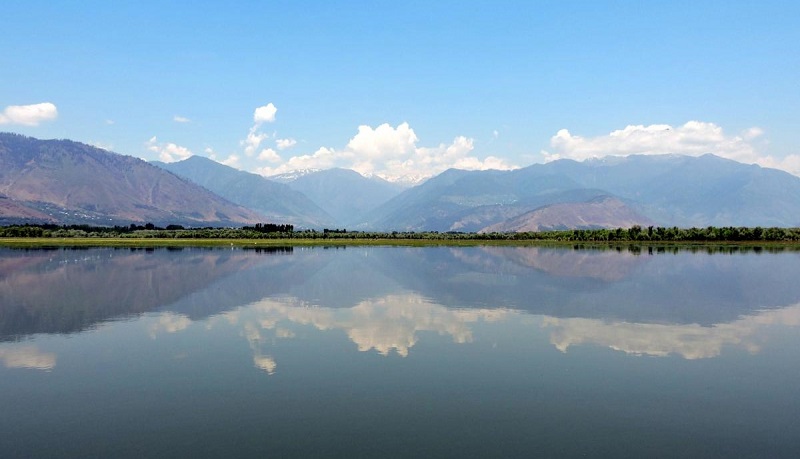
By Lalit Garg
A recent research done on the threats hovering over the world’s lakes has said that water in more than half of the world’s largest lakes and reservoirs is continuously decreasing and they are on the verge of drying up. Due to this, the future water security of humans in many parts of the earth may be at risk. Climate change, increasing heat and increasing water consumption are believed to be the biggest reasons for the drying up of lakes and large reservoirs. At a time when the acute crisis of drinking water is being felt and the emphasis is being laid on the conservation of natural sources of water, it raises new revelations and concerns from this research.
A team included scientists from the US, France and Saudi Arabia to systematically study the scourge. They looked at 1,972 of Earth’s largest lakes and reservoirs using satellite images from 1992 to 2020. They focused on large freshwater lakes largely because of the improved accuracy of satellites as well as their importance to humans and wildlife.
In this study, it was tried to see how and how much the amount of water in the lakes has changed in about 30 years. The results found that 53 percent of lakes and reservoirs showed a decline in water content at a rate of about 22 gigatonnes annually. In this way, it is a warning for the governments and social organizations working for water conservation. Lakes are a type of natural reservoir, whose water is used for drinking water and industries etc. Just as there has been a deep crisis of drinking water in many cities of the world due to the decreasing water level of the rivers, in the same way, if the lakes keep shrinking, then this crisis will become more serious.
Today, the whole world is standing under the shadow of a water crisis due to falling water levels in rivers and lakes. Unplanned industrialization, increasing pollution, decreasing deserts and glaciers, declining water level of rivers, environmental destruction, exploitation of nature and insensitivity towards its misuse are leading the whole world towards a major water crisis. Packet and bottled water are becoming symbols of development today and our carelessness towards our resources is making it easier to hand over our basic needs to marketism.
Experts have identified water as one of the major resources that will be the most challenging task to manage in the future. Rivers and lakes, which have been a source of pure water for centuries, are getting polluted due to the promotion of tourism, the water harvesting system is deteriorating, and the water level is continuously decreasing. Today, it is necessary to ensure the availability of clean and safe water from the lakes in all the countries of the world, as well as focus on the importance of water conservation. You can think how much water a human being uses in his lifetime, but does he try to save so much water?
Continuous studies have been done regarding the drying up of lakes, rivers, reservoirs and other natural water sources, the reasons are also clear from their data. But the practical measures that are expected for their protection are not being implemented. The source of the lakes is usually water coming from the mountains. It is accumulated in the form of melting snow or rainwater. But due to climate change, the way the heat is increasing all over the world, in many places there is no snow on the mountains as before and there is not enough rain. Then the ratio of the water that is produced from them has deteriorated. Due to the short duration of the rainy season and less or more amount of rain, sufficient water is not stored in the lakes. Life cannot be imagined without water.
Apart from humans and animals, water is also essential for all forms of agriculture and most industrial production processes. But about 70 percent of the earth’s area is covered with water. But, potable water is only three percent, out of this only one percent of sweet water is actually used by us. In which lakes and rivers are the main water sources. But, man does not miss wasting precious water in his tourism, health, convenience, show off and luxury.
While using water, we do not think at all about saving water, as a result of which a situation of water crisis has arisen in most of the lakes and rivers. As the temperature is rising, the water problem is taking a dire shape in many parts of India. Every year this problem is increasing more than before. The main reason for this is the ever increasing tourism and industrial commercial activities on the mountains. A major disadvantage of promoting the tourism industry has also been that commercial activities have increased in the lakes, due to which garbage has accumulated in them. Due to the lack of a regular desalting system, they have become shallow.
The banks of many lakes have been shrinking. Major lakes of the country, be it Dal Lake in Kashmir or Pushkar Sarovar or Udaipur Lakes – this is not only the result of the neglect of the governments, but also shows the apathy of the social organizations. Earlier the safety of community water sources was ensured, but now that tradition has almost ended. If the health of the lakes is to be improved, then this feeling of indifference and neglect will have to be abandoned, a planned understanding and thinking will have to be developed for the water source and conservation of the lakes.
The main water source of the water of the lakes in India is the melting of the snow coming from the mountains and the water coming from the springs. The mountains of Uttarakhand here are great examples of that. But due to the large-scale development projects started there, not only have the incidents of landslides and landslides increased, but many natural water sources are also facing danger. Due to blocking of the way of rivers and mountain springs there, the water reaching the lakes has reduced considerably. Irrational exploitation of water of many lakes has increased. They are being used extensively for industrial units.
According to a United Nations report, global water use has increased six-fold over the past 100 years, and continues to grow at a rate of about one percent per year due to increasing population, economic development, and changes in consumption patterns. Along with an erratic and uncertain supply of water, climate change has exacerbated the situation in currently water-scarce areas. In such a situation, water conservation is the only solution. Water conservation means preventing wastage of water and preventing it from getting polluted. Because if there is water then there is tomorrow. In these, it is necessary to preserve the water of the lakes and pay attention to their natural sources.
According to the research, recent drought events in different parts of the world including South India have also contributed to the declining storage of lakes and reservoirs. According to the researchers, about a quarter of the world’s population i.e. 200 million people are living in such basins where the lakes are shrinking. In such a situation, issues like human consumption, climate change and the silt accumulated in them need immediate attention.
Views expressed in the article are the author’s own and do not necessarily represent the editorial stance of Kashmir Observer
- The author is a columnist
Follow this link to join our WhatsApp group: Join Now
Be Part of Quality Journalism |
Quality journalism takes a lot of time, money and hard work to produce and despite all the hardships we still do it. Our reporters and editors are working overtime in Kashmir and beyond to cover what you care about, break big stories, and expose injustices that can change lives. Today more people are reading Kashmir Observer than ever, but only a handful are paying while advertising revenues are falling fast. |
| ACT NOW |
| MONTHLY | Rs 100 | |
| YEARLY | Rs 1000 | |
| LIFETIME | Rs 10000 | |













